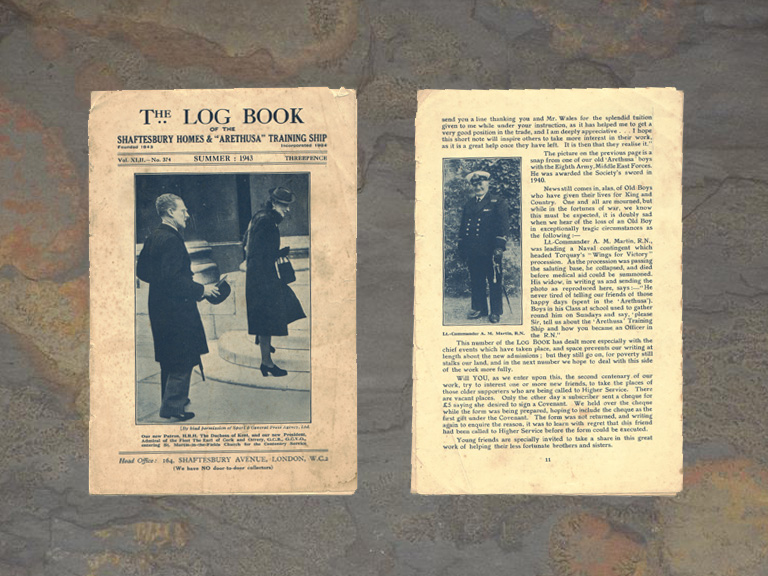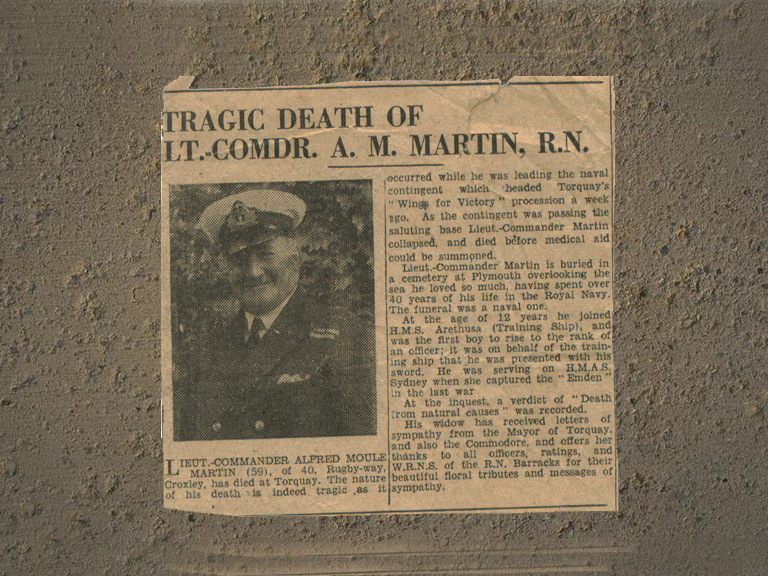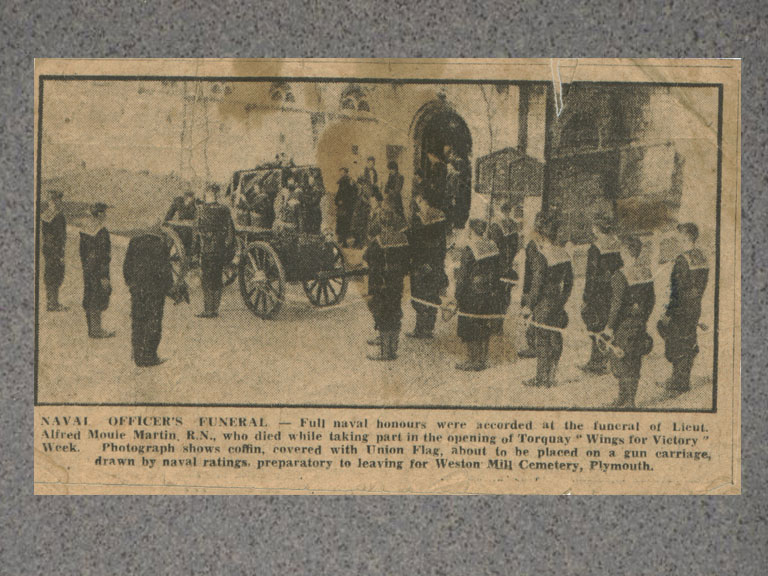Lieutenant Commander Alfred Moule Martin (RN)
Father to Joan Leggatt, was born on the 6th January 1884 in High St, Borough, Southwark (Newington, London). He died suddenly on March 6th 1943 leading Torquay’s Naval contingent “Wings of Victory” procession whilst on parade. He was 59 years of age and received a funeral with full Naval Honours. Below -Alfred Moule Martin in full ceremonial dress with his Naval Sword presented to him by the King.
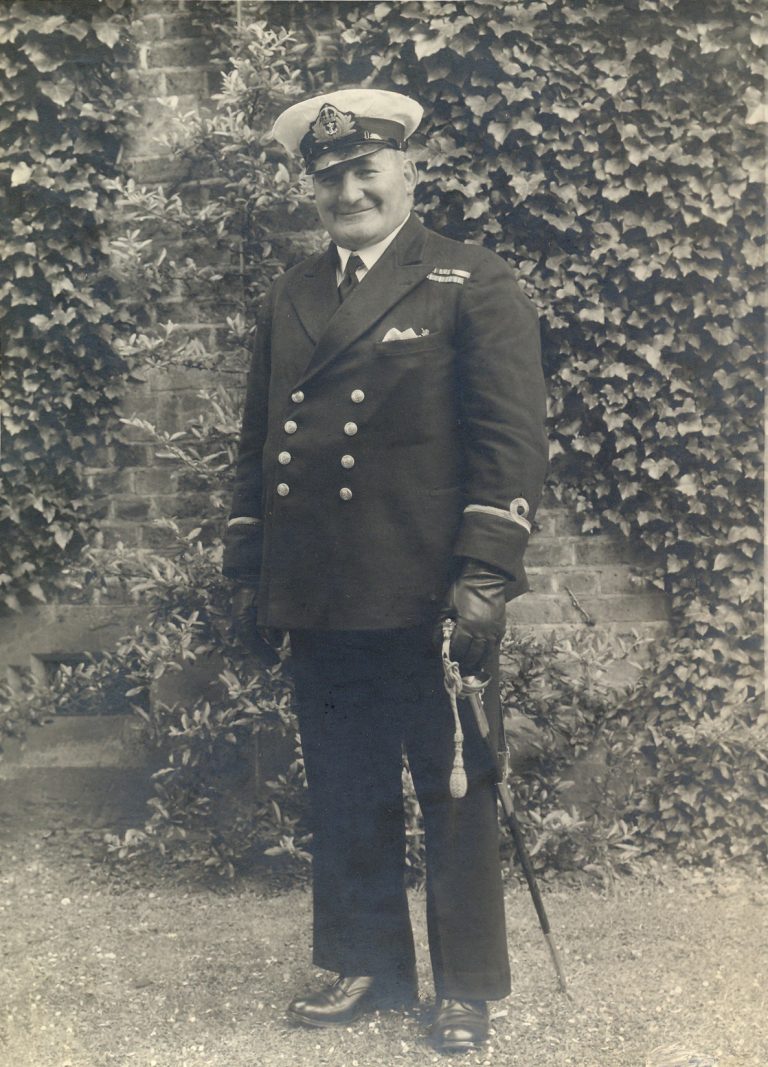
1899 -1912: Naval Training Years
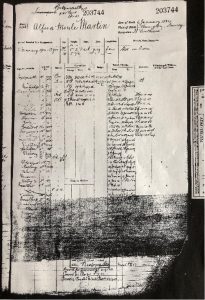
Alfred joined the navy on his 12th birthday initially the Arethusa Training Ship (image 1) and was its first boy to rise to the rank of officer: It was on behalf of the training ship that he was presented with his sword from the King.
He served on many ships, four of which are illustrated below. His naval record for ‘character’ was always ‘Very Good’ – the highest credit. HMS Impregnable, age 15years, a 98-gun second rate three-decker (image 2). He became an ‘Able seaman’ at 17 years old, recorded in the 2001 census, serving on HMS Cambridge (image 3), a gunnery training ship in Plymouth harbour before transferring to HMS Magnificent (4) as an ‘Ordinary seaman’ in1905.
His training included the HMS Victory (image 4) in Portsmouth in 1907. This ship had been relegated to second-rate, with the removal of two 32-pounder cannon and the replacement of her middle deck 24-pounders with 18-pounders obtained from other laid-up ships.
Alfred passed his Gunnery and Boswain exams in 1910

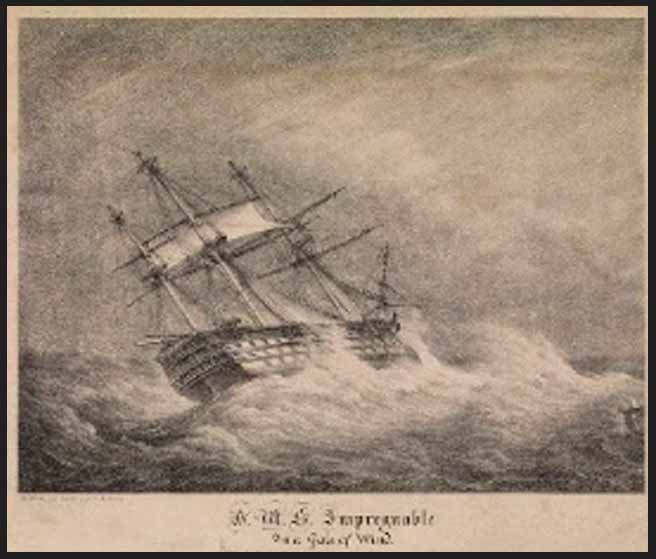
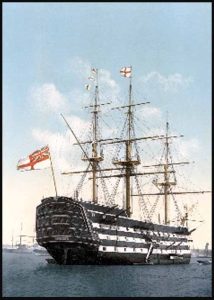
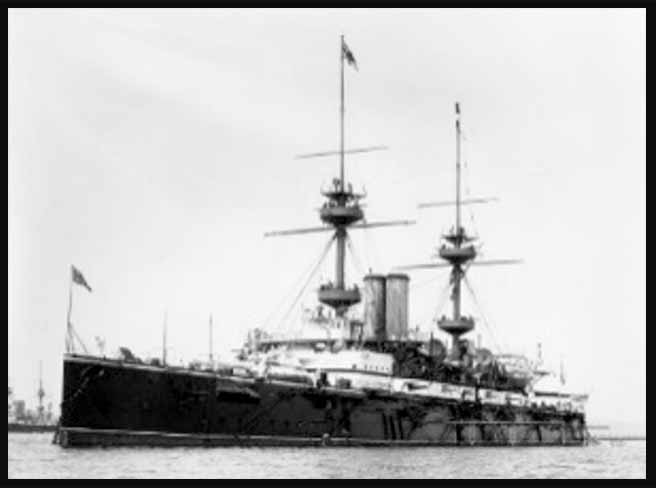
1912
Alfred Moule Martin served on HMS Blake, a big first class cruiser which was later used as a depot ship for the 2nd destroyer flotilla of the Grand Fleet.
1913 -1918: ANZAC years
1913: In June, Alfred was assigned as Bo’swain on HMASA Sydney, a light cruiser, built at Govan on the Clyde and commissioned by the Australian Navy. This post was the most senior of the deck department and was responsible for all the components of a ship’s hull including the guns and included supervision of all other members of the ship’s deck department. In his naval record, character comments written by Captain J Glossop include Alfred being ‘reliable’,’ eager’ and ’zealous’ and commissioned as lieutenant (ie a RN officer)
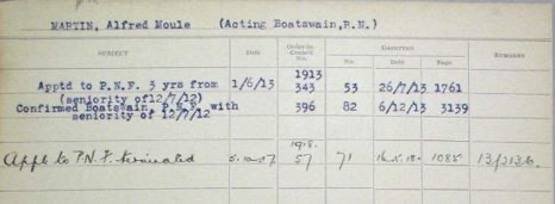
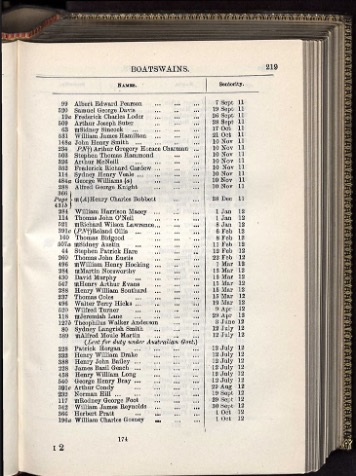
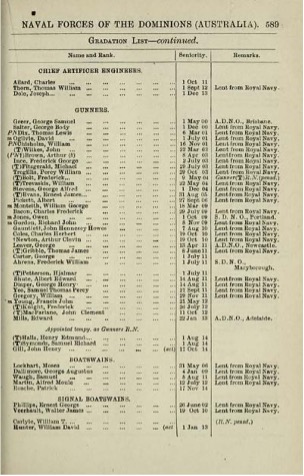
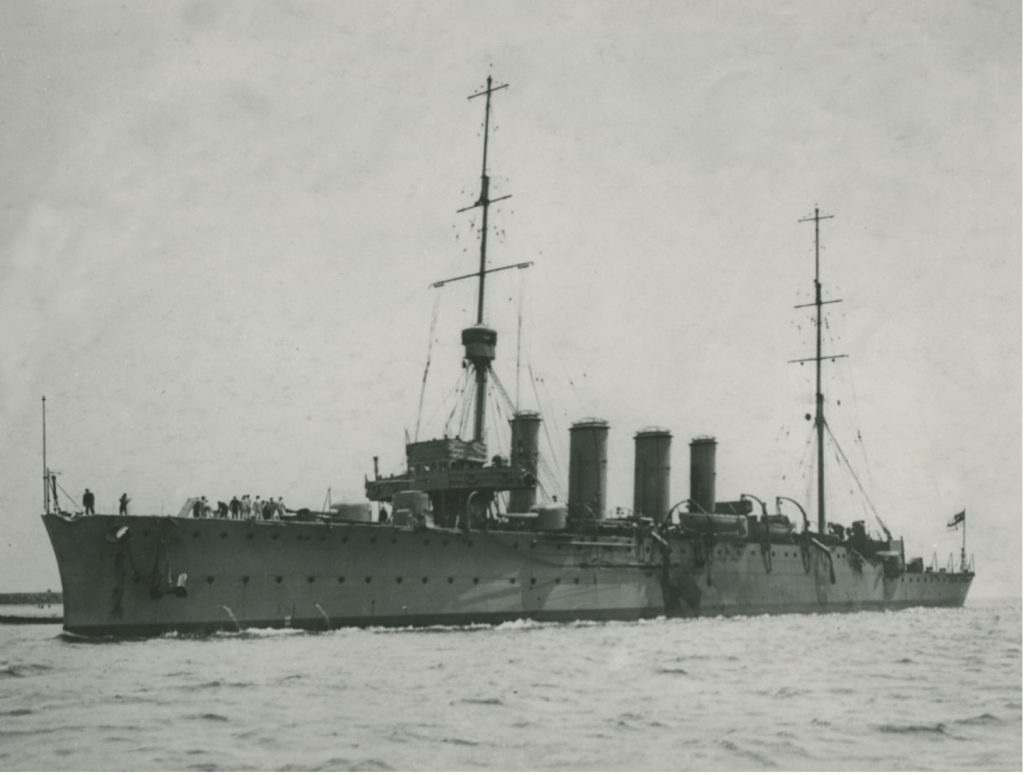
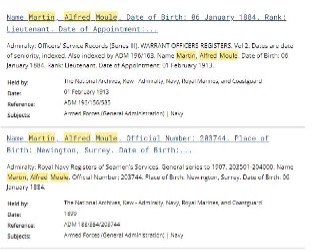
Records in Australia Archives lists Alfred married Winifred Doris Constance in 1914 in Paddington New South Wales after her divorce to William Kingdon on 27th April 2014.
1914 -1918 WW1
The most famous documentation of the HMS Sydney was its success in sinking the German Ship the SS Emden in November 1914, which was Australia`s first major naval victory. Emden was a cruiser that, at the start of World War One formed part of the German East Asiatic Squadron. October 1914, Sydney (I) and her sister ship Melbourne detached from the Flagship HMAS Australia, and returned to Australia to form part of the escort for the first ANZAC convoy which consisted of some 38 transports. The convoy sailed from Albany on 1 November 1914 and on the morning of 9 November 1914 was steaming some 50 miles east of the Cocos Islands.
“Emden, which had been completely lost after her action with the Zhemtchug, had arrived at Keeling Cocos Island and landed an armed party to destroy the wireless station and cut the cable. Here she was caught and forced to fight by H.M.A.S. Sydney. A sharp action took place, in which the Sydney suffered a loss of three killed and 15 wounded. The Emden was driven ashore and burnt. Her losses in personnel are reported as very heavy. All possible assistance is being given to the survivors by various ships which have been despatched to the scene”.
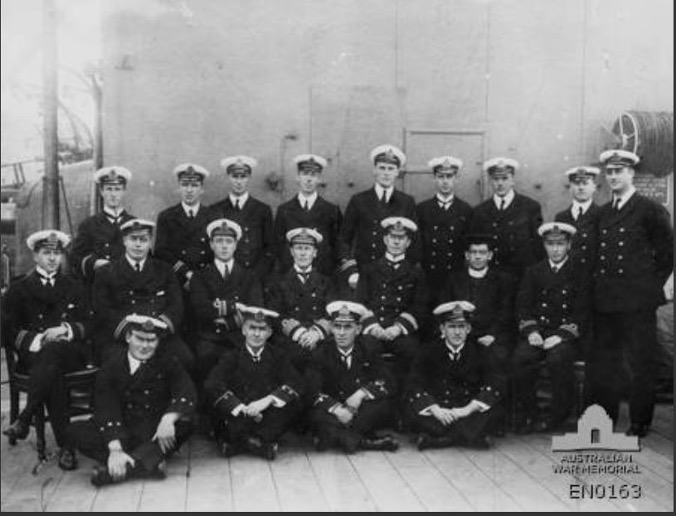
Group portrait of officers from the RAN light cruiser HMAS Sydney. The ship was on her way to the Atlantic after destroying the German raider Emden at Cocos Island on 9 November 1914. Identified left to right (back row): Assistant Paymaster Eric Kingsford-Smith; Engineer Lieutenant Cleon Dennis; Sub Lieutenant James M C Johnstone; Artificer Engineer G A Hutchinson; Lieutenant Basil Owen Bell-Salter; Lieutenant Frederick L Cavaye; Lieutenant Rupert Clare Garsia; Dr Arthur Charles Robert Todd; Gunner Lieutenant Denis E Rahilly. Middle row: Dr Leonard Darby; Engineer Lieutenant Lawrence Parsons Fowler; Lieutenant Commander John F Finlayson; Captain J C T Glossop; Paymaster Ernest Claude Norton; Chaplain Vivian Agincourt Little; Lieutenant Cuthbert John Pope (Navigator). Front row: Mr Alfred Moule Martin (Boatswain); Mr Edward Charles Behenna (Carpenter); Mr George B Salter (Gunner); Mr John C MacFarlane (Torpedo Gunner).
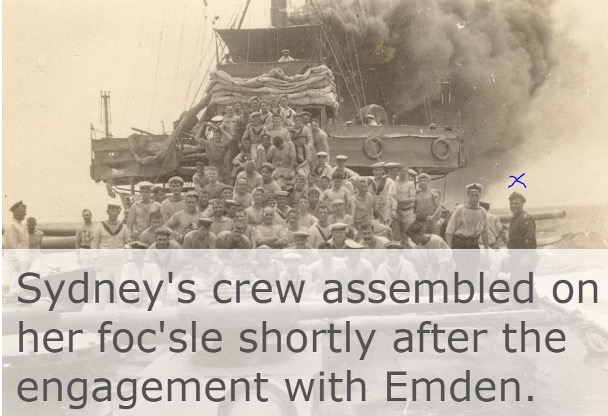

Left: An example of one of the Mexican silver dollar medallions struck for those Sydney (I) crewman who took part in the Sydney-Emden engagement. Right: The men of Sydney (I) had much to be proud of when they returned to Australia following the war’s end.
Other Medals that were awarded to Alfred Moule Martin in World War 1
The 1914–15 Star is a campaign medal of the British Empire which was awarded to officers and men of British and Imperial forces who served in any theatre of the First World War against the Central European Powers during 1914 and 1915. The medal was never awarded singly and recipients also received the British War Medal and Victory Medal.
The original British War medal was 1oz of solid silver. This is a campaign medal of the UK which was awarded to officers and men of British and Imperial forces for service in the First World War. Two versions of the medal were produced. About 6.5 million were struck in silver and 110,000 in bronze, the latter awarded to, among others, the Chinese, Maltese and Indian Labour Corps.
The Victory Medal (also called the Inter-Allied Victory Medal) is a UK and British Empire campaign medal of World War One. The award of a common allied campaign medal was recommended by an inter-allied committee in March 1919. Each allied nation would design a ‘Victory Medal’ for award to their own nationals, all issues having certain common features, including a winged figure of victory on the obverse and the same ribbon. Fourteen countries finally awarded the medal.
1915-1916: HMSA Sydney
HMSA Sydney was an escort ship participating in the military Gallipoli campaign that took place on the Gallipoli peninsula (modern Turkey), from 17 February 1915 to 9 January 1916 (https://www.gallipoli-association.org/campaign/ships-of-the-campaign/). Alfred’s active service was possibly why his wife Winifred (Joan’s mother) joined the Australian Nursing Auxiliary Corps (ANZAC) and also participated in the campaign. She would have been helping to evacuate troops at the time Alfred was serving on the HMAS Sydney (Escort). In January 1916, after eight months’ fighting, with approximately 250,000 casualties on each side, when she was serving here that she had a near miss being blown up by a bomb whilst carrying a stretcher and her hair turned white overnight.
1917
Naval service records indicate that Alfred served on HMS Blake and returned to the ‘London Depot ‘ on 30th August 1917

1920 on HMS Waspite, before joining HMS Fantome in August which was an 10-gun screw steel sloop with a full rig of sails, built for the Royal Navy and transferred to the Royal Australian Navy in 1914 but returned to the Royal Navy in 1920. This is probably the boat that Alfred sailed in to return to the UK. On the 13th March 1921, Mrs Martin requested relief of husband on compassionate grounds but this was refused. At his own request, Alfred was placed on the retirement list in May 1922 at his own request.
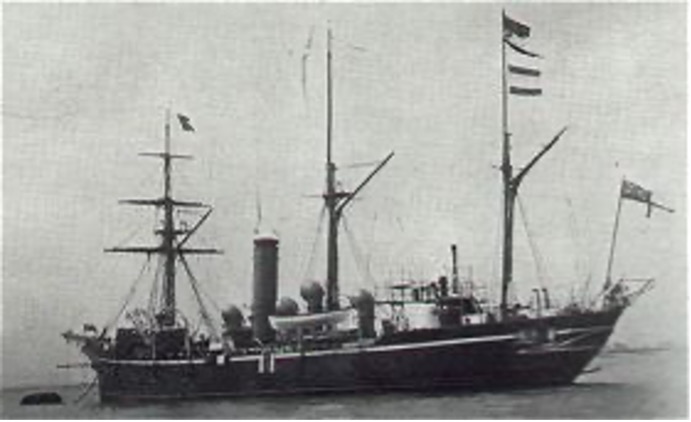

1938 - 1943 World War II
The service record suggests that Alfred was mobilised on 28th September 1938 as the rank of Lieutenant Commander and was involved with training recruits rather than active service.
Alfred Moule Martin dies tragically whilst on parade
Lieut-Commander Alfred Moule Martin (aged 59) died at Torquay whilst he was leading the naval contingent which headed the “Wings of Victory” procession. Just as he was passing the salute base. He collapsed and died before medical aid could be summoned.
Allred Moule Martin was buried in a cemetery at Plymouth with a full Naval Funeral.
